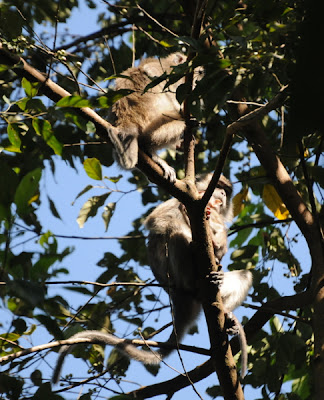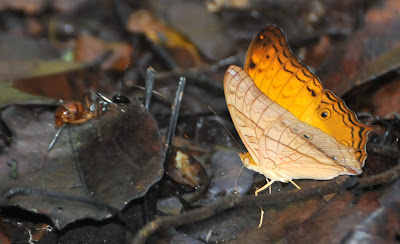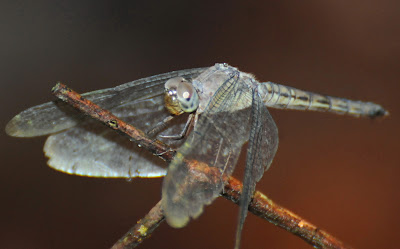The Sama Jaya Nature Reserve in Kuching has been featured here before (and undoubtedly will be again; it is definitely a nice place for a walk. These photos were taken on February 15, 2012). It's not a bad place for a bit of birding; this is a calling Chestnut-winged Babbler (Stachyris erythroptera). You can see the bare blue skin at the side of its neck that only becomes visible as it vocalises.
There is a local troop of Long-tailed Macaques (Macaca fascicularis) that are usually easy to find. Unlike some macaques elsewhere, they do not seem to approach visitors, but seem rather nervous about it - have they been harassed in the past?
Skinks are common along the pathways. They can be difficult to identify to species in the field. The upper photo shows one of the more obvious ones, a Common or Striped Tree Skink (Apterygodon vittatum). It is endemic to Borneo, and the only member of its genus. The other animal is a member of the genus Mabuya, but I can go no further in giving it a precise name.
Here is an underwing view of the Borneo race of Malay Lacewing (Cethosia hypsea hypsea).
The Grey Pansy (Junonia atlites) is a very common butterfly in open country, particularly near water.
By contrast, the Cruiser (Vindula dejone) is a common inhabitant of forests. Sama Jaya, with its small forest patch and open areas, has a cross-section of common species from both habitats (though the forest area is far too small for sustainable populations of most forest specialties).
I believe that this particularly dingy dragonfly is a female Neurothemis terminata, but I am not positive; most of the females I have seen are lighter and brighter than this one.
On a number of trips I have seen a ghostly "mystery dragonfly" coursing up and down the small stream behind the reserve, but a it never did not have a chance to place it. This photo may not be the best, but it allowed me to name it at last: a male Zyxomma obtusum, a normally-crepuscular dragonfly whose white body stands out brightly in the failing light. Females are brown, with green eyes. Its black wingtips recall another blue-eyed dragonfly, Cratilla metallica, a forest beauty with very different behaviour (at first I thought that this was Cratilla, but it acted so unlike that frequently-perching species that I was quite relieved to find out it was something else.













No comments:
Post a Comment